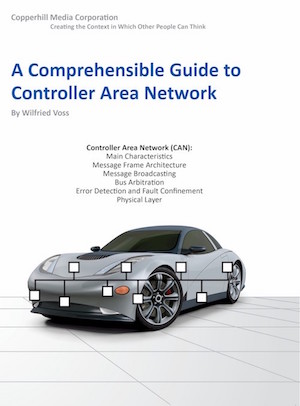Recent Posts
CAN Bus Tutorial - A Brief History of CAN
Posted by on
The following is an excerpt from A Comprehensible Controller Area Network by Wilfried Voss.
The idea of Controller Area Network (CAN) was hatched by engineers at the Robert Bosch GmbH in Germany in the early 1980s. They investigated the market for a suitable field-bus technology for use in automobiles that would enable them to add additional functionality. The main focus was a communication system between multiple ECUs (electronic control units) in vehicles by Mercedes-Benz.
Any field-bus system that is based on serial communication will reduce wiring, which was originally considered only as an advantageous side effect. Distributed control, i.e., the use of a multi-processor system, will consequently result in increased performance. The vastly reduced costs of microcontroller chips in the market already made the use of multiple processors in one system affordable. Other advantages are increased reliability and improved service and maintenance features.
However, none of the existing communication protocols did meet the specific requirements for communication speed and data reliability; as a result, they had to develop their own standard.
The involvement of a vehicle manufacturer - Mercedes-Benz- and a semiconductor manufacturer – Intel - as well as several universities in Germany has helped to make CAN a success story.
The CAN standard was first introduced in 1986 during the SAE Congress in Detroit, Michigan. The first CAN controller chips, the Intel 82526 and the Philips 82C200, were introduced in 1987.
Since then, many other semiconductor manufacturers have decided to produce stand-alone CAN controllers or implement them into their single-chip designs.
Note: The CAN protocol is protected by patents granted to Robert Bosch GmbH. Bosch will give licenses to manufacturers and universities. For more detailed information about licenses and royalties, refer to http://www.can.bosch.com/content/License.html. No CAN license required for CAN applications based on CAN devices from a licensed manufacturer.
Another crucial milestone for the success of CAN was the establishment of CAN-in-Automation (CiA) in 1992. CiA is the international users’ and manufacturers’ organization, whose activities are based on members’ interest, participation, and initiative.
PiCAN 2 - CAN Bus Interface for Raspberry Pi
This PiCAN2 board provides Controller Area Network (CAN) Bus capabilities for the Raspberry Pi. It uses the Microchip MCP2515 CAN controller with MCP2551 CAN transceiver. Connection are made via DB9 or 3-way screw terminal.
There is an easy-to-install SocketCAN driver, and programming can be accomplished in C or Python.
The PiCAN board is fully compatible with the new Raspberry Pi 4 Model B.
 Loading... Please wait...
Loading... Please wait...


